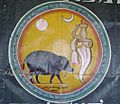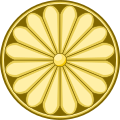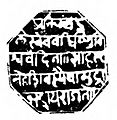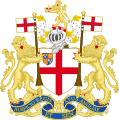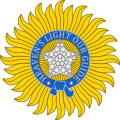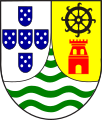State Emblem of India facts for kids
Quick facts for kids State Emblem of India |
|
|---|---|
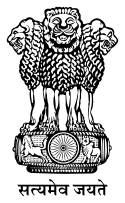 |
|
| Armiger | |
| Adopted | 26 January 1950 |
| Blazon | Lion Capital of Ashoka |
| Motto | सत्यमेव जयते (Satyameva Jayate): "Truth Alone Triumphs", from the "Mundaka Upanishad", a part of Upanishads |
The State Emblem of India is the official symbol of the Republic of India. It is used by the Indian government and many state governments. You can see it on official papers, money, and passports.
This emblem is based on the Lion Capital of Ashoka. This is a very old sculpture from about 280 BCE. It was made during the Maurya Empire. The original statue shows four lions. This symbol became the emblem for India in December 1947. It was officially adopted on January 26, 1950. This was the same day India became a republic.
The Lion Capital of Ashoka was first set up in Sarnath. This is where Gautama Buddha first taught his ideas. The emblem shows four Asiatic lions standing back to back. They represent power, bravery, confidence, and belief. The lions stand on a round base called an abacus. Below the abacus is a lotus flower.
In the middle of the abacus is the Dharma Chakra, also known as the "wheel of law." This wheel has 24 spokes. These spokes stand for progress and the growth of human civilization.
Below the abacus, you can read the motto "Satyameva Jayate." This means "truth alone triumphs." It is written in the Devanagari script. This motto comes from an ancient Indian text called the Mundaka Upanishad.
Contents
History of India's Emblem
After India became free from British rule on August 15, 1947, it needed an official symbol. On December 30, 1947, the new country chose the Lion Capital of Ashoka. At first, it was placed inside a rectangle.
The job of making the first copy of the Constitution of India beautiful was given to Nandalal Bose. He was a famous artist and teacher. Bose wanted to include the Lion Capital of Ashoka in the first pages of the constitution. He asked his student, Dinanath Bhargava, to help. Dinanath was 21 years old. He studied lions at the Kolkata Zoo to draw them very realistically.
On January 26, 1950, the Lion Capital of Ashoka was officially chosen as the State Emblem of India. The motto, Satyameva Jayate, was placed below it.
What the Emblem Looks Like

The State Emblem is a very important symbol for India. You can see it on official letters from the Government of India. It also appears on all Indian money, called the Indian Rupee. The emblem is also on Indian passports.
The original Lion Capital of Ashoka has four Asiatic lions. They stand back to back. These lions symbolize power, courage, confidence, and pride. They stand on a round base. Below them are a horse and a bull. In the center of the base is a Dharma chakra.
The round base, or abacus, has sculptures around it. These show a lion, a horse, a bull, and an elephant. They are separated by wheels. Below the abacus is a lotus flower. This flower represents life and new ideas. The whole sculpture was carved from one large piece of sandstone.
In the emblem used today, you can only see three lions. The fourth one is hidden from view. The wheel is in the center of the abacus. A bull is on the right side, and a galloping horse is on the left. There are also outlines of Dharma Chakras on the far right and left.
The bull represents hard work and being steady. The horse stands for loyalty, speed, and energy. The bell-shaped lotus flower, which was part of the original sculpture, is not included in the modern emblem.
The motto "Satyameva Jayate" is a key part of the emblem. It is written in Devanagari script below the abacus. This phrase means "Truth alone triumphs." It comes from the Mundaka Upanishad, which is a sacred Hindu text.
Emblems of Indian Organizations
Many important Indian organizations use their own emblems. These often include parts of the national emblem or similar symbols.
-
Emblem of the Supreme Court of India
Emblem on Buildings
The State Emblem is also placed on important government buildings across India. It shows the official presence of the government.
Symbols of States and Territories
Most of the states and union territories of India have their own official symbols. These are used by their local governments. However, some states and union territories use the National Emblem of India as their official symbol. They often add their name below it.
Historic Indian Symbols
Throughout history, different kingdoms and empires in India used their own unique symbols. These symbols often represented their power and beliefs.
Medieval India's Symbols
During the medieval period, various dynasties had their own royal signs.
Pandya Dynasty
-
An old royal symbol of the Pandya dynasty.
Vijayanagara Empire
-
The emblem of the powerful Vijayanagara Empire.
Ahom Kingdom
Early Modern India's Symbols
This period saw the rise of new empires and the arrival of European powers.
Mughal Empire
-
The official seal of the Mughal Empire.
Maratha Empire
The Maratha Empire also had its own seals, used by its rulers.
-
The seal of Shivajiraje Bhonsle I, the first ruler of the Maratha Empire.
-
Another seal used by Shivajiraje Bhonsle I.
Colonial India's Symbols
When European countries ruled parts of India, they used their own national symbols.
British Rule in India
-
The Coat of arms of the East India Company, used when they ruled parts of India.
-
The Coat of arms of the United Kingdom, used for official papers during British rule.
-
The Star of India, a symbol used in India during the British Raj.
Portuguese India
Portugal also had colonies in India and used its own symbols.
-
An old coat of arms for Portuguese India.
-
A smaller coat of arms for Portuguese India.
-
A larger coat of arms for Portuguese India.
-
Another larger coat of arms for Portuguese India.
French India
France also had territories in India and used French symbols.
Azad Hind
During World War II, a temporary government called Azad Hind was formed. It had its own symbols.
-
The emblem of Azad Hind.
Dominion of India
After gaining independence in 1947, India was first known as the Dominion of India. It used some symbols before the current emblem was adopted.
-
The Coat of arms of the United Kingdom was briefly used by the Dominion of India.
-
An early emblem used by the Dominion of India.
See also
 In Spanish: Emblema nacional de la India para niños
In Spanish: Emblema nacional de la India para niños
- Flag of India
- Jana Gana Mana
- Vande Mataram
- National symbols of India
- List of Indian state emblems
- List of Indian state symbols






